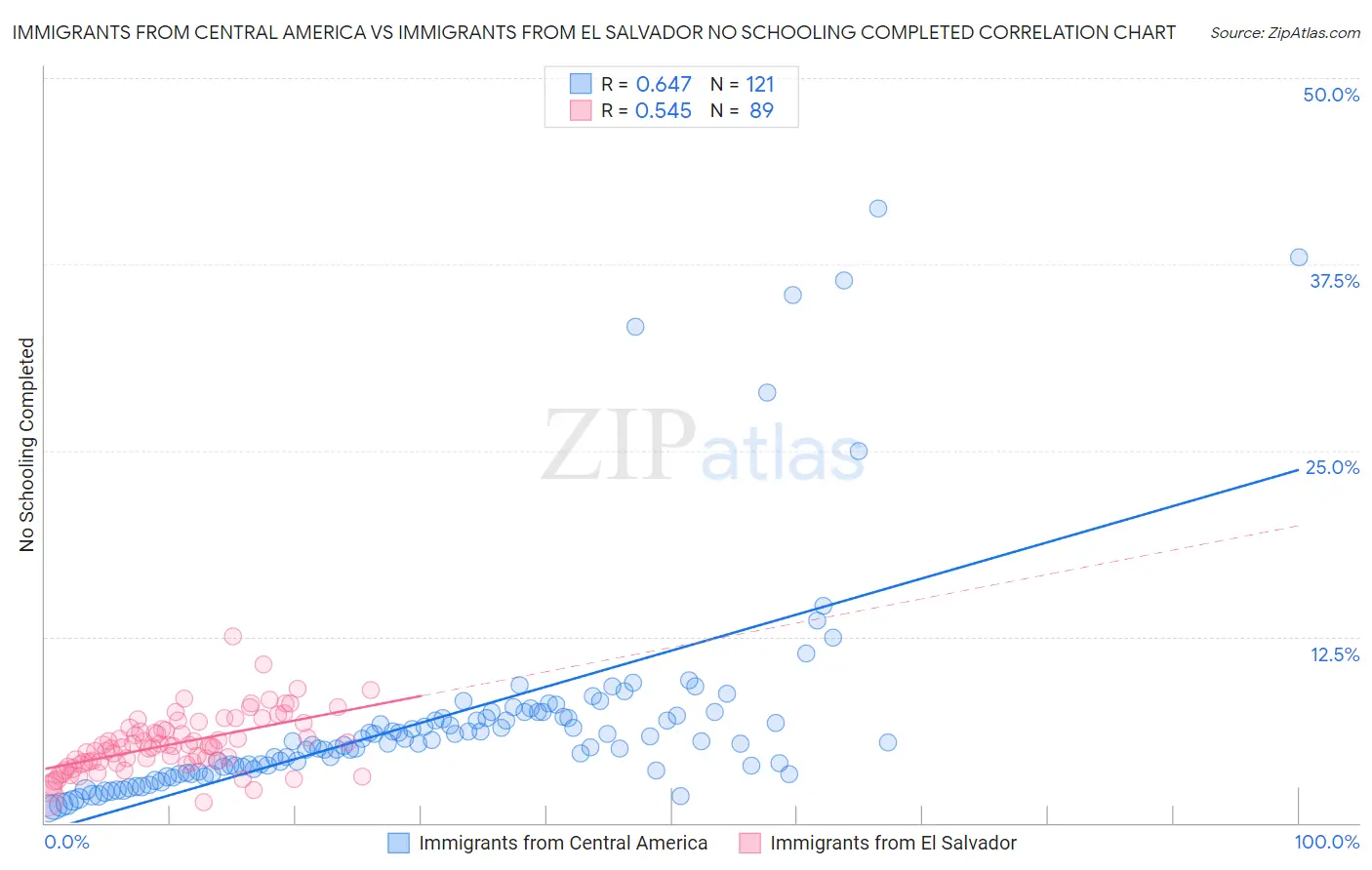Immigrants from Central America vs Immigrants from El Salvador No Schooling Completed
COMPARE
Immigrants from Central America
Immigrants from El Salvador
No Schooling Completed
No Schooling Completed Comparison
Immigrants from Central America
Immigrants from El Salvador
3.6%
NO SCHOOLING COMPLETED
0.0/ 100
METRIC RATING
341st/ 347
METRIC RANK
3.9%
NO SCHOOLING COMPLETED
0.0/ 100
METRIC RATING
345th/ 347
METRIC RANK
Immigrants from Central America vs Immigrants from El Salvador No Schooling Completed Correlation Chart
The statistical analysis conducted on geographies consisting of 525,518,504 people shows a significant positive correlation between the proportion of Immigrants from Central America and percentage of population with no schooling in the United States with a correlation coefficient (R) of 0.647 and weighted average of 3.6%. Similarly, the statistical analysis conducted on geographies consisting of 355,993,592 people shows a substantial positive correlation between the proportion of Immigrants from El Salvador and percentage of population with no schooling in the United States with a correlation coefficient (R) of 0.545 and weighted average of 3.9%, a difference of 7.3%.

No Schooling Completed Correlation Summary
| Measurement | Immigrants from Central America | Immigrants from El Salvador |
| Minimum | 1.0% | 1.4% |
| Maximum | 41.2% | 12.5% |
| Range | 40.2% | 11.1% |
| Mean | 7.0% | 5.3% |
| Median | 5.4% | 5.1% |
| Interquartile 25% (IQ1) | 3.6% | 4.0% |
| Interquartile 75% (IQ3) | 7.3% | 6.3% |
| Interquartile Range (IQR) | 3.7% | 2.3% |
| Standard Deviation (Sample) | 7.3% | 1.9% |
| Standard Deviation (Population) | 7.3% | 1.9% |
Demographics Similar to Immigrants from Central America and Immigrants from El Salvador by No Schooling Completed
In terms of no schooling completed, the demographic groups most similar to Immigrants from Central America are Immigrants from Mexico (3.6%, a difference of 0.84%), Immigrants from Guatemala (3.6%, a difference of 1.1%), Yakama (3.6%, a difference of 1.7%), Bangladeshi (3.5%, a difference of 2.1%), and Immigrants from Cabo Verde (3.5%, a difference of 2.3%). Similarly, the demographic groups most similar to Immigrants from El Salvador are Nepalese (3.8%, a difference of 1.8%), Salvadoran (3.7%, a difference of 3.5%), Immigrants from Mexico (3.6%, a difference of 6.4%), Immigrants from Yemen (4.1%, a difference of 6.4%), and Spanish American Indian (4.2%, a difference of 8.1%).
| Demographics | Rating | Rank | No Schooling Completed |
| Mexicans | 0.0 /100 | #328 | Tragic 3.3% |
| Immigrants | Vietnam | 0.0 /100 | #329 | Tragic 3.3% |
| Immigrants | Armenia | 0.0 /100 | #330 | Tragic 3.3% |
| Japanese | 0.0 /100 | #331 | Tragic 3.3% |
| Central Americans | 0.0 /100 | #332 | Tragic 3.4% |
| Immigrants | Dominican Republic | 0.0 /100 | #333 | Tragic 3.4% |
| Guatemalans | 0.0 /100 | #334 | Tragic 3.5% |
| Immigrants | Cambodia | 0.0 /100 | #335 | Tragic 3.5% |
| Immigrants | Fiji | 0.0 /100 | #336 | Tragic 3.5% |
| Immigrants | Cabo Verde | 0.0 /100 | #337 | Tragic 3.5% |
| Bangladeshis | 0.0 /100 | #338 | Tragic 3.5% |
| Yakama | 0.0 /100 | #339 | Tragic 3.6% |
| Immigrants | Guatemala | 0.0 /100 | #340 | Tragic 3.6% |
| Immigrants | Central America | 0.0 /100 | #341 | Tragic 3.6% |
| Immigrants | Mexico | 0.0 /100 | #342 | Tragic 3.6% |
| Salvadorans | 0.0 /100 | #343 | Tragic 3.7% |
| Nepalese | 0.0 /100 | #344 | Tragic 3.8% |
| Immigrants | El Salvador | 0.0 /100 | #345 | Tragic 3.9% |
| Immigrants | Yemen | 0.0 /100 | #346 | Tragic 4.1% |
| Spanish American Indians | 0.0 /100 | #347 | Tragic 4.2% |